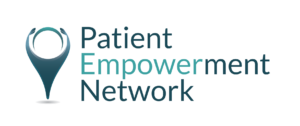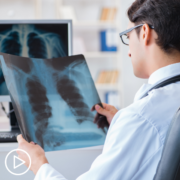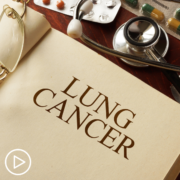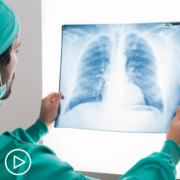Can Artificial Intelligence and Machine Learning Help Advance Screening for Lung Cancer?
Can Artificial Intelligence and Machine Learning Help Advance Screening for Lung Cancer? from Patient Empowerment Network on Vimeo.
How will lung cancer personalized medicine be improved with advanced technologies? Expert Dr. Lecia Sequist explains how artificial intelligence and machine learning help advance screening for lung cancer and shares advice for patients.
Dr. Sequist is program director of Cancer Early Detection & Diagnostics at Massachusetts General Hospital and also The Landry Family Professor of Medicine at Harvard Medical School.
[ACT]IVATION TIP:
“… if you are 50 and you have smoked in the past, I would urge you to talk to your doctor about whether you can access lung cancer screening. But if you’re younger or you haven’t smoked in the past, you can’t access lung cancer screening right now. And we’re hoping to change that with AI that can really help figure out who is at risk of this disease.”
Download Resource Guide en español
See More from [ACT]IVATED NSCLC
Related Resources:

How Do You Break Down Lung Cancer Diagnosis to New Patients? |
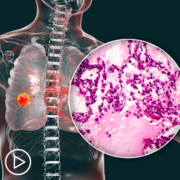
Exciting Lung Cancer Data and Studies: A Look At Neoadjuvant Treatment |

What Are the Noted Disparities in Lung Cancer Screening and Access |
Transcript:
Lisa Hatfield:
Dr. Sequist, technology is advancing at such a fast pace, and we’re hearing words like artificial intelligence and machine learning. And I just read an article about a team that you’ve been working with that is developing or has developed an AI model that can detect future lung cancer risk. I believe it’s based on CT scans. Can you speak to that a little bit more and also talk a little bit more about where you see this AI technology taking cancer research and predicting cancer and also any challenges that we might face with AI and machine learning in healthcare?
Dr. Lecia Sequist:
Yeah. AI seems to be everywhere. You turn on the news or you look at your phone, and it’s talking about AI. And some of it seems scary, and Hollywood doesn’t help because there’s lots of movies about computers or robots kind of taking over the human race. And I think we have to separate Hollywood from real life. Artificial intelligence or machine learning, it’s a very general term. It can mean a lot of different things depending on what the context is. But it’s basically just a tool for understanding patterns. And we all understand patterns in our own life or our own house. I personally know that my dog is going to want to, as soon as we wake up in the morning, is going to want to go outside and then is going to want to have some food, and there are different patterns that you know in your daily life that you recognize, and you can anticipate what’s going to happen next.
AI is a tool that helps us anticipate what’s going to happen next for patterns that are way more complex than, yeah, your dog’s going to want to go outside and eat some food. So computers can sometimes pick up patterns that the human brain can’t really pick up, because they’re just too complicated. And that’s what we’ve found in our research. One of the vaccine things about lung cancer and trying to figure out how we can prevent lung cancer or find it at the earliest stage when it’s most curable is that it’s very hard to know who’s at risk. We know that lung cancer is one of the most common cancers out there, but knowing who is truly at risk and separating one person from the next is not so simple.
In the past, it’s mainly been, you know, determined by whether or not you ever smoke cigarettes. And it’s true that cigarette smoking is one risk factor for lung cancer, but it’s not the only one. And we don’t fully understand what all the risk factors might be, but we know that there are people who have smoked a lot in their life and never get lung cancer. And on the flip side, we know that there’s people who have never smoked or who maybe quit 30, 40 years ago and will still get lung cancer. And how do we know who’s at risk? That’s what we tried to solve with our research that I worked on with my colleagues at Mass General Hospital where I work and also at MIT, Massachusetts Institute of Technology, which is just down the road from us. And so we brought together our medical knowledge and our computer knowledge and tried to come up with a way to predict for any given individual person, are they at risk for lung cancer.
By looking at their lungs and not looking at the lungs the way a human radiologist sort of says, okay, there’s the right lung, there’s the left lung, and they’re looking for things that already exist like a tumor or a mass. The computer looks at a different type of pattern that human eyes and brains can’t really recognize and has learned the pattern, because we trained the computer with thousands and tens of thousands of scans where we knew this person went on to develop cancer and this one didn’t. And the computer learned the pattern of risk. And so using an X-ray or a CAT scan to predict future risk is something a little different. In medicine, we usually use an X-ray to say, okay, what’s happening now? Why does this patient have a fever? Why is this patient bleeding? And using an X-ray or a CAT scan in this case to predict the future is kind of a new thought for doctors. But we think that it could be a really valuable tool to help us understand who’s at risk for many different kinds of diseases. We happen to look at lung cancer, but I think you could use this idea for other diseases too.
Lisa Hatfield:
So will this AI model become mainstream anytime soon if a patient wants to access that? Or is it only being used for research purposes?
Dr. Lecia Sequist:
Well, we do before we start to offer anything mainstream or as part of routine care, we really need to understand how it can be used to help patients. So we are running some clinical trials right now to try and understand, is this a tool that could be used, for example, to give someone access to lung cancer screening? Because right now, if you want to have lung cancer screening, which is a very effective screening test to try and find cancer in people who feel completely well, trying to find cancer at the earliest stage before it has spread, can we give people access to lung cancer screening by using this AI test? Right now and if you want to get lung cancer screening, you have to be 50 or older, and you have to have smoked in the past. And if that fits your, if you are 50 and you have smoked in the past, I would urge you to talk to your doctor about whether you can access lung cancer screening. But if you’re younger or you haven’t smoked in the past, you can’t access lung cancer screening right now. And we’re hoping to change that with AI that can really help figure out who is at risk of this disease.
Lisa Hatfield:
Thank you. I’m excited to see where this goes in the future.
Share Your Feedback:
Create your own user feedback survey
